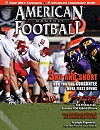Article CategoriesAFM Magazine
|
Being a Complete Running Back – Running with the ball is only one aspect of being a complete running back.by: Aaron IngramRunning Backs Coach Sacramento State University © More from this issue As coaches, we are constantly evaluating our players. And our players are constantly evaluating themselves. How many times have you had a player come to you and ask, “Coach, what do I need to do to get more playing time?” or “What do I need to work on?” At Sacramento State, we emphasis ownership. We ask them to be accountable for themselves and their performance both on and off the field. On the field, we ask the running backs “2B A PART”. This stands for:
|
|
|||||||
| HOME |
MAGAZINE |
SUBSCRIBE | ONLINE COLUMNISTS | COACHING VIDEOS |
Copyright 2025, AmericanFootballMonthly.com
All Rights Reserved





